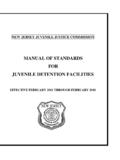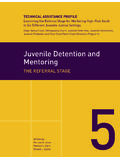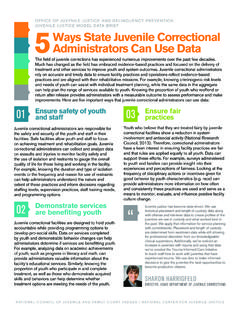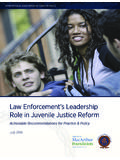Transcription of Michigan Guide to Compliance With L - MCJJ
1 THE juvenile JUSTICE & DELINQUENCY PREVENTION ACTThis material was approved by the Michigan Committee on juvenile Guide to Compliance with Laws Governing The Placement of JUVENILESIN SECURE FACILITIES THE Michigan COMMITTEE ON juvenile JUSTICE: The following persons, listed by community, have been appointed bythe Governor to the Michigan Committee on juvenile Justice:Barbara Bergman Ann Arbor, Washtenaw CountyArthur Carter Detroit, Wayne CountyLeonard Dixon Detroit, Wayne CountyJoan Doughty Ann Arbor, Washtenaw CountyHonorable William Ervin Mount Pleasant, Isabella CountyJeffrey Fink Kalamazoo, Kalamazoo County Diane Giddings Hudson, Lenawee CountyAmy Good Detroit, Wayne CountyCarol Harton Lansing, Ingham CountyJeriel Heard Farmington, Oakland CountyAnita Lacy Kalamazoo, Kalamazoo CountyMarilyn Latterman East Lansing, Ingham CountyChiquita McKenzie St.
2 Clair Shores, Macomb CountyBeatriz Netherton Glen Arbor, Leelanau CountyBrian Philson Horton, Jackson CountyJoseph Underwood Cassopolis, Cass CountyGary Walker Marquette, Marquette CountyJustice Elizabeth Weaver Glen Arbor, Leelanau CountyClarence Williams Detroit, Wayne CountyThe Michigan Committee on juvenile Justice (MCJJ) is responsible for ad-ministration of the federal juvenile Justice and Delinquency Prevention Act of 2002 in the state. MCJJ oversees disbursement of federal funds for juvenile programs and directs Compliance monitoring efforts. Members of the MCJJ are committed to the betterment of the juvenile justice system in material does not constitute a legal opinion. The material is provided for educational and informational purposes only and is not intended to be used as specific legal advice.
3 The law frequently changes and legal matters are fact specific. Viewers of this information who wish to obtain a legal opinion should obtain legal counsel for this purpose and should not act upon this information without seeking legal OF STATUS OFFENDERSADDRESS DISPROPORTIONATE MINORITY CONTACTREMOVAL OF JUVENILES FROM ADULT JAILS & LOCKUPSSIGHT & SOUND SEPARATION OF JUVENILES FROM ADULT DETAINEESIT S THE LAW3 REQUIREMENTS OF THE JJDPA The federal juvenile Justice and Delinquency Prevention Act (JJDPA) was adopted by the United States Congress in 1974. The goals of the Act are to help state and local governments prevent and control juvenile delinquency and to improve the juvenile justice system. Through the 2002 reauthoriza-tion, the JJDPA establishes four core protections with which participating states must comply to receive grants under the Act:1.
4 Deinstitutionalization of Status Offenders (DSO Requirement).Juveniles who are charged with or who have committed offenses that would not be criminal if committed by an adult ( , status offenders), must not be placed in secure juvenile facilities or in facilities designed to incarcerate Separation of juveniles from adult offenders (Separation Requirement). Juveniles alleged to be or found to be delinquent as well as status offenders and nonoffenders, may not be detained or confined in any institution in which they have contact with adult Removal of juveniles from adult jails and lockups (Jail Removal Requirement). The JJDPA states that no juvenile shall be detained or confined in any jail or lockup for adults .. The following are exceptions to this requirement: a.
5 Juveniles accused of delinquent (criminal) offenses may be locked for up to six hours for processing. b. An accused or adjudicated delinquent may be locked for up to six hours before and six hours after a court appearance. c. The jail removal requirement does not apply to juveniles formally waived or transferred to adult court and against whom felony charges have been Disproportionate minority contact (DMC Requirement). If a state identifies a disproportionate number of minority youth having contact with the juvenile justice system, then an assessment must occur, along with an intervention and Reporting. The Act requires participating states to monitor Compliance with the JJDPA by conducting site visits to law enforcement and juvenile facilities.
6 States are further required to compile and report statistical information regarding detentions of juveniles in those JJDP ACT45 STATUS OFFENDERS A status offender is a juvenile who has been charged with or adjudicated for conduct that would not be a crime if committed by an adult. Examples of status offenses are truancy, curfew violations, incorrigibility, and running addition, underage alcohol offenses are considered to be status offenses for federal Compliance purposes, even though state or local law may consider them delinquent offenses. The rationale for this classification is that not all adults, but rather a select group based on age, may be charged with possession/consumption of : Offenses such as operating under the influence of alcohol, which are criminal offenses for all adults, would be considered delinquent (criminal) offenses for juveniles as in adult facilities.
7 Under federal regulations, status offenders may not be held in a secure manner in an adult jail or lockup at any time. These juveniles may be detained in a nonsecure area of an adult jail or lockup for processing while awaiting transportation to a nonsecure shelter care facility or a juvenile detention center, or while awaiting release to a parent or in juvenile facilities. The JJDPA provides that a status offender may not be securely detained in a juvenile detention or correctional facility unless the youth has violated a valid court order. (See #4 in Questions and Answers section for further information on valid court orders.)QUESTIONS & AJUVENILE OFFENDERS6 CRIMINAL OFFENDERSU nder federal regulations, a juvenile charged with a delinquent (criminal) offense may be securely detained (locked) in an adult jail or lockup only under the following exceptional circumstances:1.
8 Accused delinquents may be locked for up to six hours to allow time for identification, investigation, processing, release to parents/guardians or transfer to a juvenile facility or to court. Sight and sound separation from adult prisoners is Accused or adjudicated delinquents held pursuant to a court appearance may be locked up to six hours before and up to six hours after the hearing to facilitate the hearing process and transport to placement. Sight and sound separation from adult prisoners is required. (NOTE: Adjudicated delinquents may not be held for any length of time in adult jails or lockups as disposition.)3. Juveniles formally waived or transferred to adult court and against whom felony charges have been filed may be locked in an adult jail or lockup.
9 * Juveniles designated for an adult trial in family court on felony level charges may be locked once probable cause has been determined by the : For purposes of calculating time for the six hour exception, the clock starts when the juvenile is placed in a locked setting or is handcuffed to a stationary object. Once the clock starts, it cannot be turned off, even if the juvenile is briefly removed from the locked setting. See Page 14 for specific waiver detention information7 NONSECURE CUSTODY A juvenile in law enforcement custody is considered to be in nonsecure custody if the following criteria are met:1. The area where the juvenile is held is an unlocked multipurpose area such as a lobby, office, or interview The juvenile is not physically secured to a handcuffing rail or other stationary The area is not designed or intended to be used for residential The juvenile is held only long enough to complete identification, investigation, processing, release to parents/ guardians or transfer to a juvenile facility or to The juvenile is under continuous visual supervision by a law enforcement officer or facility staff.
10 In addition, the following would be considered nonsecure A juvenile who is handcuffed, but not to a stationary A juvenile being processed through a secure booking area. If the juvenile is under visual supervision and remains in the booking area only long enough for photographing, fingerprinting or a breathalyzer test, the juvenile is not considered to be in secure A juvenile placed in a secure police vehicle for A juvenile placed in a room that contains doors with delayed egress devices that have been approved in writing by the authority having jurisdiction over fire codes. In no case shall this delay exceed 30 CUSTODY8 SECURE DETENTIONS ecure detention or confinement status has occurred within a jail or lockup when a juvenile is physically detained or confined in a locked room, set of rooms, or a cell.








